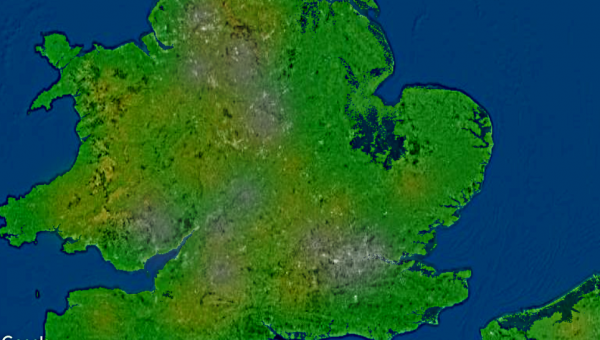BY LETTER
Climate Change on Old Earth
History > 0030 to 0900 AT: Solsys Era > 030 to 130 AT: The Information Age
History > 0030 to 0900 AT: Solsys Era > 130 to 400 AT: The Interplanetary Age
History > 0030 to 0900 AT: Solsys Era > 400 to 530 AT: The Solsys Golden Age
Science > Biology > Ecology
Technology > Application > Envirotech
History > 0030 to 0900 AT: Solsys Era > 130 to 400 AT: The Interplanetary Age
History > 0030 to 0900 AT: Solsys Era > 400 to 530 AT: The Solsys Golden Age
Science > Biology > Ecology
Technology > Application > Envirotech
 Image from Steve Bowers | |
| With a two-metre rise in average sea levels, many densely populated regions were inundated, including parts of the UK and France | |
Beginnings
The first steps toward the climate crisis that would eventually engulf the Earth began during the ancient Industrial Revolution that set humanity on the path toward a high technology civilization. The combustion of large quantities of carbon-based fuels, along with deforestation, soil erosion, and animal agriculture, produced a sharp increase in the level of atmospheric carbon dioxide. This gas, in combination with other byproducts of industrial civilization such as chlorofluorocarbons, began in turn to trap more and more solar heat in the planetary atmosphere, causing an overall rise in temperatures, and disrupting weather, climate, and environmental patterns across the globe.The Interplanetary Age Climate Crisis
By 231 AT (2200 CE), the climate crisis had reached its peak. Average global temperatures had risen by 4 degrees Celsius, mostly at the poles, while sea levels had risen by an average of 2 meters. Ocean currents were disrupted by the melting of icecaps and glaciers (the Arctic Ocean became ice free and navigable in summer), and increasing water temperatures, combined with deoxygenation and acidification, resulted in large losses of both marine life and habitats.At the same time, the climate itself became more extreme. Stronger and more frequent storms had begun in the Information Age, with a concomitant increase in property damage, injuries, and death. But the storms of the Interplanetary Age were stronger and more disruptive still, while across the world as a whole wetter regions saw increasing levels of precipitation and drier regions became ever more arid. Simultaneously, plant growth patterns began shifting significantly North and South, allowing the farming of fruits, vegetables and grains in areas where such had not been viable before - but more importantly leaving what had been the largest and most developed farming areas of the planet either barren or having to scramble to adapt to both new growing conditions and new pests, parasites, and diseases that came with them.
Impact on the Biosphere
The combination of warming oceans and warming atmosphere had a devastating impact on the biosphere. Everything from the general biodiversity of the planet to ocean-based food supplies was threatened. Fueled by the various environmental changes, the Holocene extinction accelerated, threatening or causing the extinction of massive numbers of plant and animal species. Almost as damaging was the impact of the many species that not only survived, but went on to thrive and breed at unprecedented rates once their various competitors and predators had succumbed.Some of the most notable examples of biospheric disruption from the period included:
- The invasive population boom of jellyfish into the depleted fish habitats of North America and Asia.
- Mass plant die-offs (most dangerously impacting staple food crops) due to pollinator extinction and,
- The rapid desertification of equatorial and tropical regions, most famously characterized by the near total disappearance of the rainforests of Brazil and the Congo.
Impact on Mindkind
While civilization did not fall due to climate change, the resulting disruptions varied from significant to severe. Mass migrations, driven by rising seas or drying climate destabilized or depopulated entire regions, often radically altering yet other areas as refugees clashed with local populations. Governments fell, and several polities became extinct as a result.Turning the Tide
Despite the environmental and civil upheavals wracking the planet, a growing wave of changes, both great and small, first slowed, and then gradually reversed the climate crisis.Changes in Society
Across the varied societies of Earth, new habits of behavior and cultural norms began to reduce the impact of mindkind on the planet. These included, but were not limited to:- Changes in eating habits and food production to more sustainable practices, ranging from the use of more efficient plants (natural and gengineered), to the consumption (and consumer acceptance) of insect based protein across most of the planet.
- The eventual near total acceptance of gengineering as a tool and method to address a wide range of challenges. Eventually this would lead to the creation of several of the first Tweak clades, adapted to live more comfortably in the new conditions prevailing on Earth (and eventually other worlds discovered or engineered to have similar conditions).
- Increasing urbanization, leading to decreasing environmental impacts per capita through economies of scale. This trend actually reversed itself in later centuries, as the implementation of other technologies to combat climate change also reduced the advantages offered by increased urbanization or even rendered them superfluous.
- Comprehensive environmental policies utilizing real-time surveillance driving the adoption of green technologies and behaviours.
Changes in Technology
At least as important as the changes in Terran social structure, were the varied technologies, some new, some known about for centuries, that were put into operation to first stabilize and then repair and reconstitute the planetary biosphere. This included:Energy Generation and Transport
- The use of commercial fusion power, with the first commercial reactor coming online in 2057 CE, and additional reactors being added to the grid every 3-5 years thereafter.
- A combination of new and renewable sources being added to the planetary energy mix, including wind, ground and space-based solar, and micro-nuclear and hydropower installations. Taken together, these systems did much to both diversify and localize the energy grid, providing a powerful secondary source, even as fusion retained a dominant role.
- Durable low-cost, high-temperature (liquid nitrogen) superconductors were invented in 2043 CE, allowing energy to be more efficiently transported from remote solar and wind power installations to population centers. As use of green energy increased, fewer fossil fuels were required. The invention of room temperature superconductors in 2238 CE only accelerated this process.
- Using the new superconducting technologies, everything from cars to airplanes was eventually electrified.
- Increased use of telepresence, virtual reality, and telecommuting to reduce the amount of travel that took place.
- Use of automated cars, trucks, and buses to transport and deliver food, raw materials, finished goods, and sophont passengers, reducing the number of vehicles in use, and incidentally the number of accidents.
- Increased use of bicycles, scooters (often self-driving and self-balancing), and public transit.
Manufacturing and Materials
- The growing use of molecular manufacturing allowed the creation of advanced materials, lighter and stronger than anything available before, reducing weight and increasing efficiency.
- Fabbing and early nanomanufacturing systems allowed many goods, and even some foodstuffs, to be created in people's homes or at local production centers, reducing or eliminating the need for transportation systems to deliver them.
- Advanced materials resulted in the creation of such tools as Vacuum Insulated Membranes, drastically reducing the need for heating and cooling in buildings, and the energy consumed thereby.
 Image from Anders Sandberg | |
| The Berthelot Arcology, a major biotech city grown north of Sardinia, one of many climate remediation measures. The grass-like covering provided photosynthetic energy and absorbed CO2, while the many shafts and canyons provided both air and sunlight to the apartments. Deeper inside lay geothermal generators, internal parks and immune nodes. | |
Infrastructure
The new materials and manufacturing techniques, combined with advances in automation, including ever increasing numbers of ever more capable robots, made the creation of massive new projects both practical and economical. These included ecologically-optimised arcologies, air-conditioned Aysee Tents, efficient Vac-Train networks, and various carbon-sequestration, land reclamation, or climate modification systems (such as the so-called 'diamond trees,' bot constructed dikes and seawalls, and fleets of semi-autonomous cloud-seeding ships).Envirotech
The need to repair, replace, and maintain the damaged or lost ecosystems of Earth led to the rise of the first envirotech systems. While primitive by the standards of later eras, they often represented the best of cutting edge technology for the time. Envirotech systems included such tools as:- Synsect pollinators used to replace the many insect and bird species lost or endangered.
- Biotech fields and forests full of non-replicating gengineered plants designed to alter the atmosphere or soil, initially used to reduce global CO2 levels or as a prelude to reintroduction of native species, although eventually this became an end in itself as first biotech and later nanotech manufacturing came to be seen as a superior use of the reclaimed land.
- The use of exo-wombs to rapidly breed endangered species back to more sustainable levels. While used in a few cases, the technique never became sufficiently economical or widespread to do anything more than slow the impact of the Holocene extinction.
Related Articles
- Arcology
- Burning Library Project
- Earth
- Ecosystem - Text by M. Alan Kazlev
Community of organisms - whether biological or alife - interacting with one another and with the chemical and physical factors making up their environment. - Environment
- Environmental Engineering - Text by M. Alan Kazlev, from the original by Robert J. Hall
Ensuring environments remain favourable to bionts. Includes both environmental protection (pollution control, waste recycling or treatment) and habitat biosphere optimization, biont hygiene and health issues and standards, and biosphere engineering in general (biospherics). - GAIA
- Holocene Extinction
Appears in Topics
| 030 to 130 AT: The Information Age | 130 to 400 AT: The Interplanetary Age | 400 to 530 AT: The Solsys Golden Age |
| Ecology | Envirotech |
Development Notes
Text by Todd Drashner
Initially published on 01 November 2016.
Initially published on 01 November 2016.






